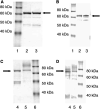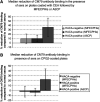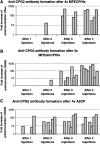Modifying an immunogenic epitope on a therapeutic protein: a step towards an improved system for antibody-directed enzyme prodrug therapy (ADEPT)
- PMID: 15162148
- PMCID: PMC2409521
- DOI: 10.1038/sj.bjc.6601888
Modifying an immunogenic epitope on a therapeutic protein: a step towards an improved system for antibody-directed enzyme prodrug therapy (ADEPT)
Abstract
Carboxypeptidase G2 (CP) is a bacterial enzyme, which is targeted to tumours by an antitumour antibody for local prodrug activation in antibody-directed enzyme prodrug therapy (ADEPT). Repeated cycles of ADEPT are desirable but are hampered by human antibody response to CP (HACA). To address this, we aimed to identify and modify clinically important immunogenic sites on MFECP, a recombinant fusion protein of CP with MFE-23, a single chain Fv (scFv) antibody. A discontinuous conformational epitope at the C-terminus of the CP previously identified by the CM79 scFv antibody (CM79-identified epitope) was chosen for study. Modification of MFECP was achieved by mutations of the CM79-identified epitope or by addition of a hexahistidine tag (His-tag) to the C-terminus of MFECP, which forms part of the epitope. Murine immunisation experiments with modified MFECP showed no significant antibody response to the CM79-identified epitope compared to A5CP, an unmodified version of CP chemically conjugated to an F(ab)(2) antibody. Success of modification was also demonstrated in humans because patients treated with His-tagged MFECP had a significantly reduced antibody response to the CM79-identified epitope, compared to patients given A5CP. Moreover, the polyclonal antibody response to CP was delayed in both mice and patients given modified MFECP. This increases the prospect of repeated treatment with ADEPT for effective cancer treatment.
Figures







Similar articles
-
A strategy for mapping and neutralizing conformational immunogenic sites on protein therapeutics.Proteomics. 2002 Mar;2(3):271-9. doi: 10.1002/1615-9861(200203)2:3<271::aid-prot271>3.0.co;2-w. Proteomics. 2002. PMID: 11921443
-
Sustained tumor regression of human colorectal cancer xenografts using a multifunctional mannosylated fusion protein in antibody-directed enzyme prodrug therapy.Clin Cancer Res. 2005 Jan 15;11(2 Pt 1):814-25. Clin Cancer Res. 2005. PMID: 15701872
-
Catalytic activity of an in vivo tumor targeted anti-CEA scFv::carboxypeptidase G2 fusion protein.Int J Cancer. 2000 Feb 15;85(4):571-7. Int J Cancer. 2000. PMID: 10699932
-
Glucarpidase (carboxypeptidase G2): Biotechnological production, clinical application as a methotrexate antidote, and placement in targeted cancer therapy.Biomed Pharmacother. 2023 Oct;166:115292. doi: 10.1016/j.biopha.2023.115292. Epub 2023 Aug 12. Biomed Pharmacother. 2023. PMID: 37579696 Review.
-
Antibody-directed enzyme prodrug therapy (ADEPT) with mustard prodrugs.Anticancer Drug Des. 1995 Jul;10(5):361-72. Anticancer Drug Des. 1995. PMID: 7639927 Review.
Cited by
-
Removal of B cell epitopes as a practical approach for reducing the immunogenicity of foreign protein-based therapeutics.Adv Drug Deliv Rev. 2009 Sep 30;61(11):977-85. doi: 10.1016/j.addr.2009.07.014. Epub 2009 Aug 11. Adv Drug Deliv Rev. 2009. PMID: 19679153 Free PMC article. Review.
-
Recombinant immunotoxin against B-cell malignancies with no immunogenicity in mice by removal of B-cell epitopes.Proc Natl Acad Sci U S A. 2011 Apr 5;108(14):5742-7. doi: 10.1073/pnas.1102746108. Epub 2011 Mar 21. Proc Natl Acad Sci U S A. 2011. PMID: 21436054 Free PMC article.
-
Bypassing evolutionary dead ends and switching the rate-limiting step of a human immunotherapeutic enzyme.Nat Catal. 2022 Oct;5(10):952-967. doi: 10.1038/s41929-022-00856-6. Epub 2022 Oct 19. Nat Catal. 2022. PMID: 36465553 Free PMC article.
-
Engineering CAR-T cells to activate small-molecule drugs in situ.Nat Chem Biol. 2022 Feb;18(2):216-225. doi: 10.1038/s41589-021-00932-1. Epub 2021 Dec 30. Nat Chem Biol. 2022. PMID: 34969970 Free PMC article.
-
Design and engineering of deimmunized biotherapeutics.Curr Opin Struct Biol. 2016 Aug;39:79-88. doi: 10.1016/j.sbi.2016.06.003. Epub 2016 Jun 17. Curr Opin Struct Biol. 2016. PMID: 27322891 Free PMC article. Review.
References
-
- Bagshawe K, Sharma S, Springer C, Antoniw P (1995) Antibody directed enzyme prodrug therapy: a pilot scale clinical trial. Tumor Target 1: 17–30
-
- Baert F, Noman M, Vermeire S, Van Assche G, D’ Haens G, Carbonez A, Rutgeerts P (2003) Influence of immunogenicity on the long-term efficacy of infliximab in Crohn's disease. N Eng J Med 348: 601–608 - PubMed
-
- Bhatia J, Sharma SK, Chester KA, Pedley RB, Boden RW, Read DA, Boxer GM, Michael NP, Begent RHJ (2000) Catalytic activity of an in vivo tumour targeted anti-CEA scFv::carboxypeptidase G2 fusion protein. Int J Cancer 85: 571–577 - PubMed
-
- Braun A, Kwee L, Labow MA, Alsenz J (1997) Protein aggregates seem to play a key role among the parameters influencing the antigenicity of interferon alpha (IFN-alpha) in normal and transgenic mice. Pharm Res 10: 1472–1478 - PubMed
Publication types
MeSH terms
Substances
LinkOut - more resources
Full Text Sources
Other Literature Sources
Miscellaneous

